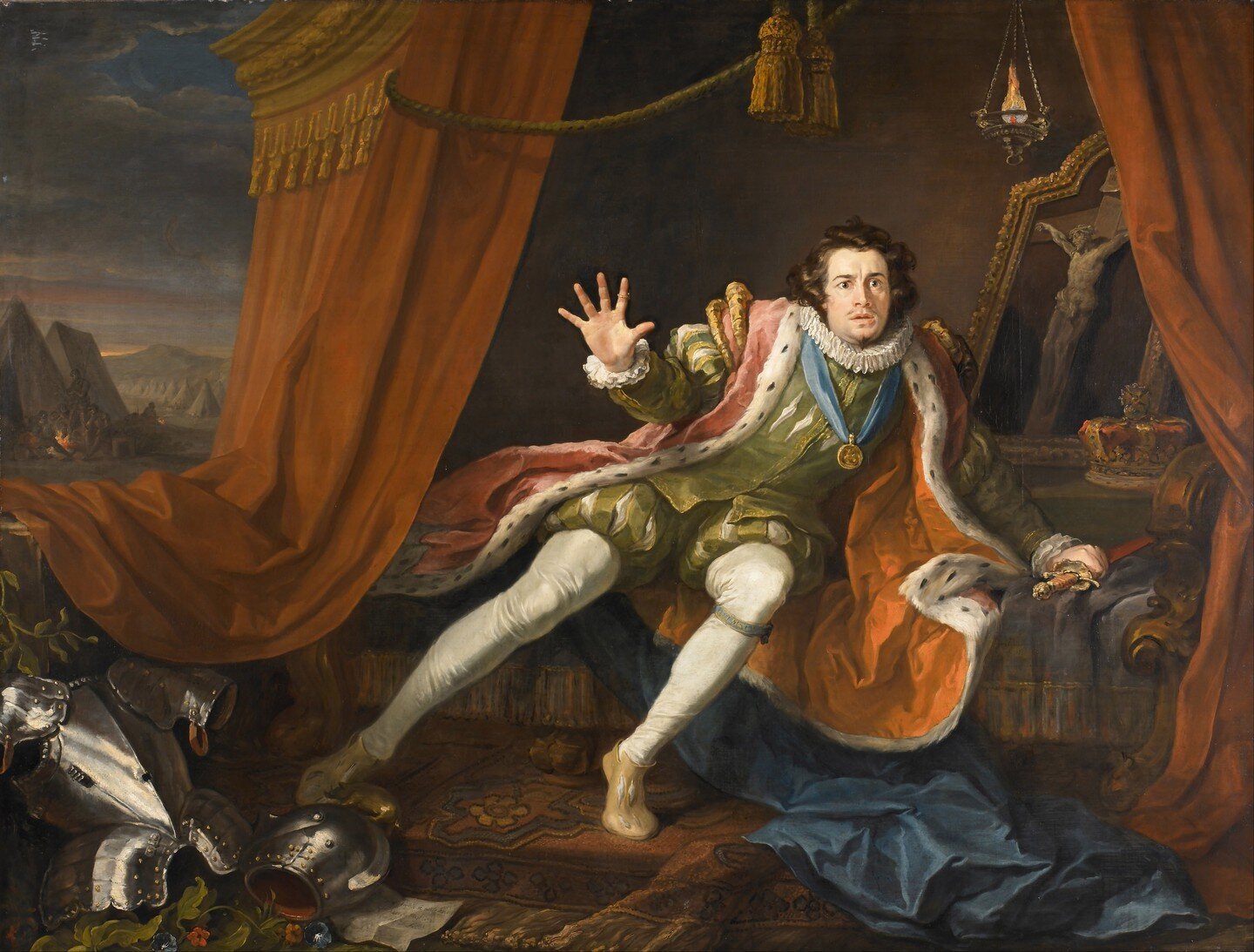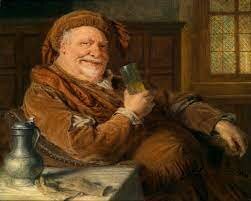Misdiagnosing Shakespearean Modernism
William Hogarth's David Garrick as Richard III
In my previous essay, I suggested that a “housing bubble” in the humanities is fueling intellectual gentrification. The high valuation placed upon “relevant” knowledge incentivizes scholars to frame their research and construct their syllabi to satisfy their students’ (i.e., consumers’) preferences. Advertisements for professorships and calls for contributions to scholarly collections also funnel scholars toward hyperspecialized research in extraordinarily niche fields. Meanwhile, more historically significant content languishes in the doldrums of manufactured obsolescence. The story is undoubtedly more complicated than I describe. Universities operate within cultural milieus that shape their priorities. Economic incentives also play a profound role: student debt soars as colleges endlessly hike tuition to fund bloated administrations and campus amenities, even as the vocational advantage a degree affords has evaporated. Nevertheless, I think these are epiphenomena of historiographies that have taught us how to categorize and assess knowledge. We become the stories we have told.
In this essay, I want to explore the ways modernity has been narrated through a framework of secularization by using New Historicist readings of Shakespeare’s tetralogies as a case study—readings which are the latest iterations in a long tradition of attempts to separate religion from literature. Brian Cummings argues (I think correctly) that English literature emerged as a distinct discipline by disambiguating itself from religion; prominent literary critics distinguished their field by emphasizing their subject matter’s secularity. Thus in A. C. Bradley’s seminal work Shakespearean Tragedy (1904), he observed, “The Elizabethan drama was almost wholly secular; and while Shakespeare was writing, he practically confined his view to the world of non-theological observation and thought . . .” Cummings argues that throughout the twentieth century, the scholarly consensus was that Shakespeare “saw the world in a ‘non-theological’ way,” a view shared by scholars as diverse as Harold Bloom, Stephen Greenblatt, Roland Mushat Frye, and George Santayana. Cummings concludes: “Literature appears where angels fear to tread. A theory of secularization, in this sense, lies at the origin of the study of English as a discipline. The absence of religion from the plays of Shakespeare is therefore not incidental, but axiomatic to the emergence of modernity.”
The most influential recent version of this thesis comes from New Historicism, a vein of criticism that emerged in the 1980s and 90s that seeks to understand works not as the product of individual genius but instead as the products of the cultural context in which they arose. Its proponents usually presume the following: 1) expressive utterances are never separate from material processes that enable them or which undergird society, 2) literary texts are inseparable from non-literary texts or cultural formations, and the two mutually influence each other, 3) texts participate in hegemonic discursive systems, none of which can stake a claim for incontestable, capital-T Truth, and 4) the critic’s job is to unmask, disenchant, expose, and critique such systems.
Beginning from this position, New Historicist critics usually conceptualize the emergence of the early modern stage as an “evacuation-and-replacement” narrative. When late medieval Catholicism collapsed under the weight of its contradictions and abuses (the story goes), the energies bound up in sacramental rituals migrated from the church to the secular stage, because dramas, like sacraments, are performed signs. The combination of nostalgia for old traditions and artistic emancipation from premodern genre conventions materialized in the emergence of a commercial replacement for the banned medieval religious drama. C. L. Barber argues that English theater audiences had a “famished, insatiable spiritual hunger” for Catholic ritual. Louis Montrose casts the new drama as “another form of compensation” for banned rites, razed icons, and stripped ceremonies—the “mystery, magic, spectacle, [and] theatricality” of Catholic Christianity. In this view, the secular stage inexorably rises as the material conditions of performance whittle away at a religious worldview’s plausibility structures. The vanguard of New Historicism, Stephen Greenblatt, classifies theatrical performance as an inherently demystifying act that “kills the credibility of the supernatural.” Shakespeare, who wrote after the rediscovery of atomistic materialism and the “swerve” toward modernity, becomes a “decisively secular dramatist” liberated from the shackles of premodern superstition.
Falstaff with Pewter Jug and Wineglass by Eduard von Grützner
Subsequent critics overlay this framework onto Shakespeare’s history tetralogies, which narrate the story from Richard II’s deposition and assassination in 1399 to the rise of Tudors in 1485. After the Lancastrians (Henry IV, Henry V, and Henry VI) take over after Richard II, they struggle to beat back rival factions (both foreign and domestic); the victories of the first two kings evaporate when the Yorkists dethrone Henry VI and rule briefly. Richard III’s Machiavellian takeover crescendos in incessant civil war until Henry Tudor emerges victorious at Bosworth Field. He marries Elizabeth of York to unite the Lancastrian and Yorkist claim to the throne and founds the Tudor dynasty.
In the 1930s, E. M. W. Tillyard’s landmark Shakespeare’s History Plays implied that critics should read the tetralogies in order of historical chronology, as the Folio lists them, not in compositional order. Read in this manner, the saga celebrates the Tudors’ rise as England’s divinely appointed saviors. To this day, scholars are haunted by this patriotic, providentialist reading and constantly erect it as a foil for their own interpretations, which see Shakespeare as ironizing patriotism and divine-right political theory and celebrating the emergence of disenchanted, secular, utilitarian modernity. Most recent scholars agree that the second tetralogy (Richard II, 1 Henry IV, 2 Henry IV, and Henry V) unravels the providential conclusion of the first (1 Henry VI, 2 Henry VI, 3 Henry VI, and Richard III). The second tetralogy heralds the dawning of modern language, modern plots, modern means of characterization, modern views of political power, etc.
For example, Leonard Barkan claims, “Henry IV has, by accident or design, created the style of the modern world,” and any proper reading must “recognize . . . that the modern world actually begins earlier than the Henry IV plays, with the birth of Henry’s kingship in Richard II.” In the 1990s, Jean Howard and Phyllis Rackin updated his claim: Henry V is a “thoroughly modern” monarch, and beginning with Richard III, the histories mark an unmistakable descent into modern models of kinship, sociological structures, methods of jurisprudence, political and civic affiliation, and, above all, constructions of gender. Henry V’s “politically motivated theatrical self-presentation” demonstrates his modern sensibility of the division between man and role; the constriction of female agency in the second tetralogy “represents a movement into modernity, the division of labor and the cultural restrictions that accompanied the production of the household as a private place, separated from the public arenas of economic and political endeavor.” Richard II’s lavish opulence and moral degeneracy align him with the “polluting forces of effeminate modernity.” As king, Henry V conceives of national identity in “strikingly modern terms,” and when he imagines a brotherhood of Englishmen devoid of class markers, he sets forward a conception of England as a “prototype of the modern nation state.”
Notice the implication: once Shakespeare became a man, he put away childish things. As he honed his craft, he dispensed with Richard III’s tidy, naïve conclusion that cast the Tudors as divinely-appointed ministers of justice whose rule curtailed England’s chaos and factionalism. When Shakespeare matured, he realized that real political power is brutal, materialistic, disenchanted, Machiavellian. Real dialogue is full of slurs and double-entendres. Real religion is a front for economic and political exploitation. Real gender negotiations are predicated on power, and women are pawns in a patriarchal game. These Shakespeareans, in my view, wish to see the playwright as a progenitor of their own project of exposure, disenchantment, and social critique, and their readings contort the histories to make them accord with modern sensibilities. In other words, if Shakespeare is the first disenchanted modern artist, literary critics can press his creations into service to assist in their social critique of discursive systems.
I do not contest that the question of modernity is at the heart of the histories, nor do I quibble that the symptoms of modernity that other critics have identified—social fragmentation, disenchantment, malaise, linguistic ambiguity, materialism, Machiavellian politics—are indeed present in the plays. But these are symptoms of modernity, not causes. In my final installment, I will show how Shakespeare’s history plays can be read more fruitfully if one recognizes the theological origins of modernity: the collapse of what Louis Dupré has called the “ontotheological synthesis” attendant to Aquinas and his followers’ embrace of Aristotelian metaphysics.


